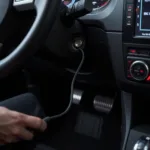The OBD2 port, or On-Board Diagnostics port, on your Dodge Ram is a critical component for vehicle diagnostics and maintenance. This port allows you to connect a scan tool, like an OBD2 scanner, to access your truck’s computer system and retrieve valuable information about its performance. Whether you’re experiencing engine issues, want to check for trouble codes, or are simply looking to gain a deeper understanding of your Ram’s inner workings, knowing the location of your OBD2 port is essential.
Where is the OBD2 Port on a Dodge Ram?
For most Dodge Ram models from 1996 onwards, the OBD2 port is located on the driver’s side, under the dashboard, and near the steering column. It’s typically a rectangular, 16-pin connector, often covered by a small plastic door or cap.
Here’s a step-by-step guide to locating the OBD2 port in your Dodge Ram:
- Sit in the driver’s seat and ensure the parking brake is engaged.
- Look beneath the steering column towards the pedals.
- Feel around the area for a rectangular-shaped port. It may be slightly recessed or covered.
- If you find a plastic cover, gently pry it open to reveal the OBD2 port.
Note: The exact location of the OBD2 port may vary slightly depending on the model year and trim level of your Dodge Ram. If you’re having trouble finding it, consult your owner’s manual for a diagram or specific instructions.
Troubleshooting Common OBD2 Port Issues
While accessing the OBD2 port is usually straightforward, you may encounter a few common issues:
1. Can’t Locate the Port:
- Double-check the location: Ensure you’re looking in the right area beneath the dashboard.
- Consult your owner’s manual: Refer to the manual for a diagram or precise instructions.
- Check for modifications: If your truck has aftermarket modifications, the previous owner might have relocated the port.
2. Damaged or Blocked Port:
- Inspect the port for dirt, debris, or damage: Clean it gently using compressed air or a cotton swab.
- If pins are bent or damaged, you may need to have the port repaired or replaced by a qualified mechanic.
3. No Power to the Port:
- Check your vehicle’s fuses: A blown fuse related to the OBD2 port could be the culprit. Refer to your owner’s manual for fuse box locations and diagrams.
- Test the cigarette lighter: If the cigarette lighter isn’t working, it could indicate a broader electrical issue affecting the OBD2 port as well.
Why is the OBD2 Port Important?
Understanding your Dodge Ram’s health is crucial for its longevity and your peace of mind. The OBD2 port serves as the gateway to this understanding, allowing you to:
- Diagnose engine problems: Retrieve and interpret diagnostic trouble codes (DTCs) to pinpoint engine issues.
- Monitor vehicle performance: Track parameters like speed, RPM, engine temperature, and fuel efficiency.
- Reset warning lights: Clear check engine lights or other warning lights after addressing the underlying issue.
- Customize vehicle settings: Some advanced scan tools allow for customization of certain vehicle features.
Conclusion
Locating and understanding the function of the OBD2 port in your Dodge Ram is an essential aspect of vehicle ownership. This simple port empowers you to take control of your truck’s diagnostics and maintenance, ensuring a smoother, more enjoyable driving experience for years to come.
Remember, if you encounter persistent issues or are uncomfortable troubleshooting electrical problems yourself, it’s always best to consult a qualified mechanic.
FAQs
1. What year did Dodge Ram start using OBD2 ports?
All Dodge Ram models manufactured from 1996 onwards are equipped with OBD2 ports.
2. Can I use any OBD2 scanner on my Dodge Ram?
While most standard OBD2 scanners will work, it’s recommended to choose a scanner that’s compatible with your specific Dodge Ram model year and engine type for optimal functionality.
3. What should I do if my OBD2 port is not working?
If you’ve checked the fuses and the port for damage but it’s still not working, it’s best to consult a qualified mechanic to diagnose and address the issue.
4. Can I leave an OBD2 scanner plugged in all the time?
While you can leave some scanners plugged in for short periods, it’s generally not recommended to leave them connected permanently. This is because it could drain your vehicle’s battery, especially in older models.
5. Does the OBD2 port affect my vehicle’s warranty?
Using the OBD2 port for diagnostics or to connect a compatible device will not void your vehicle’s warranty. However, making unauthorized modifications or using incompatible devices could potentially affect your warranty coverage.
For more information on specific Dodge Ram models, you can find detailed articles on our website:
- 2001 Dodge Laramie OBD2 Port
- 2004 Dodge Ram 2500 OBD2 Port Replacement
- 2001 Dodge Ram 2500 Diesel OBD2 Port
- OBD2 Port 2005 Dodge Ram 1500
- 2001 Dodge Ram OBD2 Port
If you need further assistance, please don’t hesitate to contact our 24/7 support team via WhatsApp: +1(641)206-8880 or Email: [email protected]. We’re always here to help!


